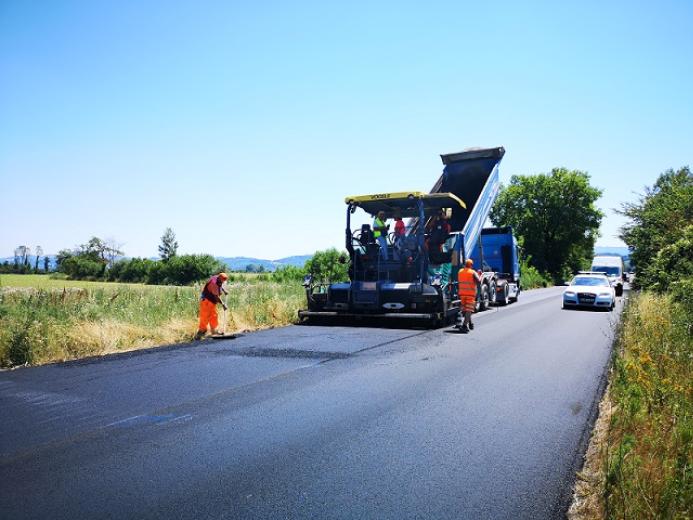The University of Pisa has collaborated to the Project. Thanks to the Nereide project, the University has gained great experience in the study of low noise emission surfaces, and also Ecopneus with reference to technical assistance.
 At the beginning of July, Anas started the works for renovating the surface of the “Senese-Aretina” State Road n 73, experimenting a noise reduction solution on a 2.6 km long stretch of road. The investment is estimated at 800,000 Euros, included the remaking of the deeper road structures. The intervention was carried out in the towns of Monterchi and Anghiari in the Province of Arezzo. The stretches of road were identified at Km 175-176, in the area of “San Leo”, with an extension of about 1600 m and speed limit at 70 Km/h; the second stretch of road (900 m long, 50 km speed limit) was in the residential area known as “Le Ville” – at about the 168th Km of the State Road n 73.
At the beginning of July, Anas started the works for renovating the surface of the “Senese-Aretina” State Road n 73, experimenting a noise reduction solution on a 2.6 km long stretch of road. The investment is estimated at 800,000 Euros, included the remaking of the deeper road structures. The intervention was carried out in the towns of Monterchi and Anghiari in the Province of Arezzo. The stretches of road were identified at Km 175-176, in the area of “San Leo”, with an extension of about 1600 m and speed limit at 70 Km/h; the second stretch of road (900 m long, 50 km speed limit) was in the residential area known as “Le Ville” – at about the 168th Km of the State Road n 73.
This activity has seen the collaboration of Tuscany’s departmental area of Anas, which has taken care of the project management. The Engineering and Testing department has coordinated the activities and will carry out the measurements of noise reduction performances, as well as the quality of the newly-laid road surfaces thanks to its Centre of the town of Cesano. In particular, they have verified the characteristics of adherence of the experimental layers, which is a fundamental parameter for the aims of road safety. The Department of Civil and Industrial Engineering of the University of Pisa has collaborated to the project. This Department has already gained vast experience in the study of low noise surfaces during the course of the projects Leonardo (financed by Region Tuscany and now terminated) and the ongoingNereide project (financed as LIFE project by the European Union). In particular, the University has developed some specific mixes studying the balancing among the requisites of minimum noise emissions and the ones of adequate characteristics of adherence to the speed of transit provided for. Also Ecopneus and Lucos have participated in this project. In collaboration with the companies Asphalt Rubber Italia and Valli Zabban, Ecopneus has offered technical assistance in the definition and supply of the specific materials; Lucos, instead, has effectively carried out the work on behalf of Anas.
The noise reduction layers are of three types:
- Wear layer of dense graded type with optimised weaving made with hot bituminous mixture.
- Wear layer of dense graded type with optimised weaving made with highly-workability warm bitumen with additives modified with SBR/NR polymers obtained from rubber powder derived from End-of-Life tyres according to the “wet” process.
- Wear layer of dense graded type with optimised weaving made with highly-workability warm bitumen modified with SBR/NR additives polymers obtained from rubber powder derived from End-of-Life tyres according to a “dry” process.
Simply speaking, the three mixtures in bituminous conglomerate that have been studied are characterised by an “optimised” granule curve. In this special granule curve, the particular distribution of the dimensions of the inert aggregates in the mixture is able to move part of the noise emissions caused by tyres rolling on the surface to frequencies that are softened at short distance from the point of contact between tyre and surface, thus, guaranteeing low noise emissions.
In the second and third mix, the use of rubber powder has been provided for. This material derives from a specific process of grinding of End-of-Life tyres, which modifies the rheological properties of the bituminous binder and, as a consequence, the viscous-elastic characteristics of the bituminous mastic. Such modification allows the surface weaving to be more stable in the course of time and, as a consequence, to preserve its acoustic performance. In the case of the “wet” process, the powder is used in the liquid phase for its dissolution in the bituminous binder. In the “dry” process, instead, the rubber powder is added to the mixture as a solid aggregate.
In both cases, the production process provides for relatively low temperatures upon laying the asphalt. This is done in order to avoid the breaking of the sulphur bonds present in vulcanised rubber. Thus, the objective is to minimise the production of unpleasant fumes and emissions during the asphalt laying phase.
Particular attention has been paid to the characterisation of gaseous emissions during the asphalt laying phase. In the photos here-below, the tests carried out by the ASL of the city of Siena are highlighted. ASL have carried out measurements of the polluting gaseous emissions on the workers of the worksite, the work vehicles, and by the means of a control unit placed on the side of the worksite area. The fourth photo shows the temperature of the conglomerate upon laying.
In addition to the three experimental layers, also some “standard” stretches of road have been resurfaced (the so-called “B-type standard wear”, present in the specifications of Anas) to compare the noise emissions performances of the special layers with the ones of “new”, ordinary surfaces in optimal conditions. The same comparison has been made between the “new”, ordinary surfaces and the old or damaged surfaces.
Recent experimental results (both the ones deriving from the studies of the University of Pisa in the project “Leopoldo” that dates to some years ago, and the ongoing LIFE “Nereide” project) as well as the results of the European Project LIFE MONZA (http://www.lifemonza.eu/?q=it/node/27), allow to calculate a net gain of 4-6 dB in noise levels emitted from the optimised road layers, compared to traditional surfaces.
In practice, however, the interventions that will repair also old or damaged stretches of road will be able to produce even greater positive effects in the perception of the resident population affected by the noise problem.

 Collect ELT
Collect ELT